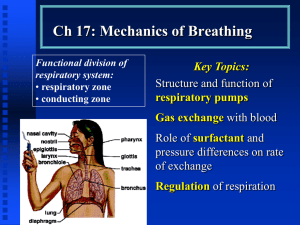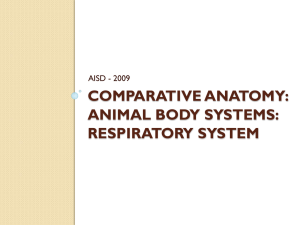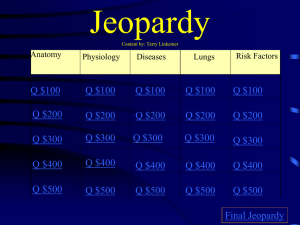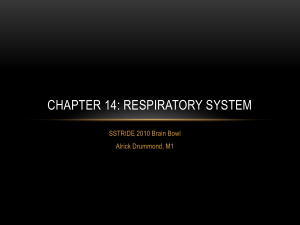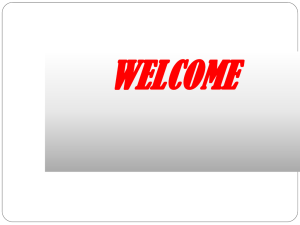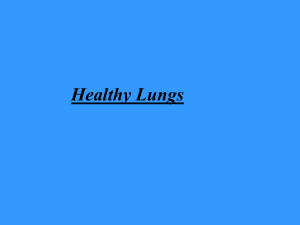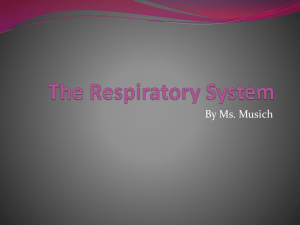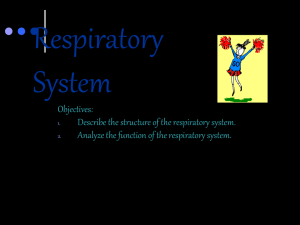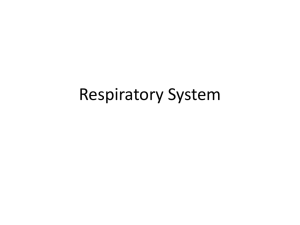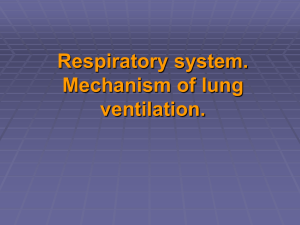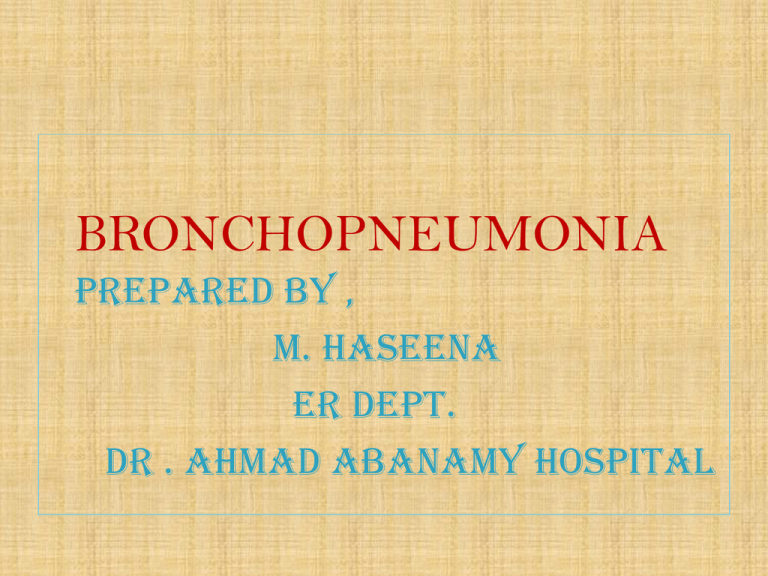
BRONCHOPNEUMONIA
PREPARED BY ,
M. HASEENA
ER DEPT.
DR . AHMAD ABANAMY HOSPITAL
NURSING CASE STUDY OF A PATIENT
WITH BRONCHOPNEUMONIA
Demographic data
NAME :X
AGE : 9 YEARS
SEX : MALE
NATIONALITY :TURKISH
DATE OF ADMISSION :12/01/13
CHIEF COMPLAINTS :fever,COUGH ,
SOB.
DIAGNOSIS : BRONCHOPNEUMONIA
PHYSICAL ASSESSMENT
:
GENERAL APPEARANCE
Child is looking dull respiratory distress present, wheezing present, skin
is warm to touch
Vital signs:
Temperature : 38.8°c
Heart rate : 115 /mnt,
Respiration : 54 b/ mnt nasal flaring present
Blood pressure : 100/ 80 mmHg
Spo2
: 88 % in room air
GENERAL MEASUREMENT
Head circumference – 44cm
Chest circumference –28cm
Weight -33kg
Length -110cm
•PHYSICAL ASSESSMENT
SKIN
• Normal skin colour
• Hair soft and silky
• Warm to touch
• Nails to end of fingers and often extend
NOSE
• Nostrills patent bilaterally
• Nasal flaring present
• Nasal discharges present
PHYSICAL ASSESSMENT
MOUTH AND THROAT
• Uvula midline
• Secretion present
• Tongue moves freely
• Gag reflex present
• Teeth is normal in colour
• Productive cough present
NECK
• Short neck present
• Turns side to side easily
• No lymph node enlargement present
PHYSICAL ASSESSMENT
CHEST
• Bilateral chest movement present
• Nipple is symmetrical
• Retraction present
• Crackles present
• Decreased breath sound present
• Tachycardia present
ABDOMEN
• Soft to palpate
• Umbilicus is normal
• Bowel sound is normal on auscultation
PHYSICAL ASSESSMENT
GENITALIA
• Urinary meatus at tip of glans penis
• Palpable testes in scrotum and is normal in shape
• Adequate voiding and defecation present
BACK
• Spine is intact
• No spinal deformity present
EXTREMITIES
• Full range of motion present
• Ten fingers and ten toes present
• Nails are normal in shape and colour
MILESTONES OF DEVELOPMENT
MILESTONES
BOOK BASE
PATIENT BASE
GROSS MOTOR
Enjoying team games, eg: foot
ball, tennis, cricket
Are able to swimm
Showing increased body
awareness and awareness of own
physical skill
MET
FINE MOTOR
Can use adult type tools such as
saws and hammers
Handwriting become more
legible
Increase writing speed
Writing can occur well without
ruled lines
MET
MILESTONES OF DEVELOPMENT
TALKING AND UNDERSTANDING
Use and understand very
complex language
PRESENT
SOCIAL
Able to resolve problems like
fight with friends and siblings
Ability to understand others
point of view
PRESENT
INTELLECTUAL
Depends on the school curriculum
IMMUNIZATION STATUS
VACCINE
BIRTH
1MOS
HEP B
2MOS
4MOS
6MOS
9MOS
12MOS
15MO
S
1923MOS
2-3YRS
4-6YRS
RV
DPT
Hib
PCV
IPV
INFLUE
NZA
MMR
VARIC
ELLA
HEP A
MCV 4
18MOS
7-10YRS
ABBREVIATION OF VACCINES
•
•
Hep B
RV
: Hepatitis B
: Rotavirus
•
•
•
•
•
•
•
DPT
HiB
PCV
IPV
MMR
Hep A
MCV 4
: Diphtheria , Pertuses, Tetanus
: Haemophilus influenza type B
: Pneumococcal vaccine
: Inactivated poliovirus
: Measeles, Mumps, Rubella
: Hepatitis A
: Meningococcal virus
PATIENT HISTORY
Past Medical History: patient Xs is known case of bronchial asthma since
childhood.
And he is on medication (nebulization) , and no other
treatment .
Present medical history: patient xs is came to ER Dept due to the complaints of
high grade fever, severe cough, since 2 days.
Shortness of breath , poor oral intake since one day.
Seen and examined by our ER Paediatrition,
nebulisation with ventolin, atrovent and pulmicort
given. Inj . hydrocortisone 100mg IV given .But no
improvement so the patient is admitted to ward for
further conservative management
Surgical history :
patient xs has no present and past
surgical history
TOPIC PRESENTATION
• Bronchopneumonia is a severe type of pneumonia
that is characterized by multiple areas of acute and
isolated consolidation that affect one or more
pulmonary lobes. It is one of the most serious
infection in childrens.The disease assumes alarming
proportion if both the lungs are affected. Great care
has to be taken if the patient suffers from
bronchopneumonia. If it is left untreated, the
outcome may be fatal.
BRONCHOPNEUMONIA IMAGES
BRONCHOPNEUMONIA IMAGES
CROSS SECTION OF BRONCHOPNEUMONIA
AFFECTED LUNGS
ANATOMY AND PHYSIOLOGY OF
RESPIRATORY SYSTEM
• The respiratory system is situated in the thorax, and is responsible for
gaseous exchange between the circulatory system and the outside
world.
RESPIRATORY SYSTEM
RESPIRATORY SYSTEM
ANATOMY AND PHYSIOLOGY
The respiratory system is represented by the following structures
THE NOSE
•
It consist of the visible external nose and the internal nasal cavity. The nasal
septum divide the nasal cavity into right and left sides. Air enters two opening ,
the external nares (nostrils and naris ) and pasess into the vestibule and through
passages called meatuses. The bony wall of the meatus called concha , are
formed by the facial bone ( the inferior nasal concha and the ethmoid bone ) .
from the meatuses the air then funnels into left and right internal nares. Hair ,
mucus, blood capillaries and cilia that lines the nasal cavity filter, moisten ,warm
and eliminate debris from the passing air .
ANATOMY AND PHYSIOLOGY
PHARYNX : The pharynx ( throat ) consist of the following three region ,
listed in
order through which incoming air passess
NASOPHARYNX : It receives the incoming air from the two internal nares ,
the two auditory tubes that equalize the air pressure in the middle ear
also enter here . the pharyngeal tonsils ( adenoid ) lies at the back of the
nasopharynx.
OROPHARYNX : It receives air from the nasopharynx and food from the
oral cavity , the palatine and lingual tonsils are located here .
LARYNGOPHARYNX : It passess food to the oesophagus and air to the larynx
ANATOMY AND PHYSIOLOGY
THE LARYNX
: It receives air from the laryngopharynx . it consist of several piece of
cartilage that are joined by membranes and ligaments .
EPIGLOTTIS
It is the first piece of cartilage of the larynx , is a flexible flap that covers the
glottis . the upper region of the larynx , during swallowing to prevent the
entrance of the food .
THYRIOD CARTILAGE
It protect the front of the larynx , a forward projection of this cartilage
appears as the ADAMS apple ( laryngeal prominence ) .
ANATOMY AND PHYSIOLOGY
The upper vestibular folds ( false vocal cords ) contain muscle fibres that
brings the folds together and allow the breath to be held during periods
of muscular pressure on the thoracic cavity ( eg : straining while
defecating , or lifting a heavy object )
The lower vocal folds ( true vocal cords ) contain elastic ligament that
vibrate when skeletal muscle move them into the path of out going air .
various sound including speech are produced in this manner .
CRICOID CARTILAGE
These are supporting the larynx
ANATOMY AND PHYSIOLOGY
TRACHEA
The trachea ( wind pipe )is a flexible tube about 10-12 cm long and 2.5 cm in diameter
The mucosa is the inner layer of the trachea contain mucus producing goblet cells and
pseudo stratisfied ciliated epithelium . the movement of the cilia sweeps debris away
from the lungs towards the pharynx .
The submucosa is a layer of areolar connective tissue that surround the mucosa .
The adventitia is the outermost layer of the trachea . it consist of areolar connective
tissue .
LUNGS
The lungs are a pair of cone shaped bodies that occupy the thorax , the mediastenum ,
the cavity containing the heart , separate the two lungs . left and right divided by the
fissure into two and three lobes . each lobe is further divide d into lobules with
terminal bronchioles . blood vessels , lymphatic vessels and nerves penetrate each
lobe .
ANATOMY AND PHYSIOLOGY
The lungs are the sites for gaseous exchange, and are situated within the
thoracic cavity. They occupy 5% of the body volume in mammals when
relaxed., and their elastic nature allow them to expand and contract
with the process of inspiration and expiration.
Pleura is a double layered membarane consisting of an inner pulmonary (
visceral ) pleura which surround each lung . the narrow space between
the two membarane is the pleural cavity is filled with pleural fluid , a
lubricant secreted by the pleura .
Each lung has the following superficial features
The apex and the base identify the top and bottom of the lung
The costal surface of each lung borders the ribs
On the medial ( mediastenal surface ) where each lung faces the other lung
, the bronchi , blood vessels, and lymphatic vessels enter the lungs at
the hilus .
ANATOMY AND PHYSIOLOGY
The primary bronchi are two tubes that branch from the trachea to the left and
right lungs .
Inside the lungs , each primary bronchus divides
repeatedly into branches of secondary
( lobar )
bronchi , tertiary (
segmental ) bronchi , and numerous bronchioles , including terminal bronchioles
and respiratory bronchioles . the wall of the primary bronchi is constructed like
the trachea , but as the branches of the tree get smaller . the cartilaginous rings
and the mucosa are replaced by smooth muscle .
ALVEOLAR DUCTS
These are the final branches of the bronchial tree . each alveolar ducts has enlarged
bubble like swelling along its length . each bubble is called alveolus . some
adjacent alveoli are connected by alveolar pores .
The respiratory membrane consist of the alveolar and capillary walls . gas exchange
occurs across these membarane .
ANATOMY AND PHYSIOLOGY
The characteristics are
TYPE 1 CELLS
: are thin , squamous epithelial cells that constitute the alveolar wall . oxygen
diffusion occurs across these cells .
TYPE 2 CELLS
: These are cuboidal epithelial cells that are interspersed among type 1 cells . it
will secrete pulmonary surfactant that reduce the surface tension of the moisture that cover the
alveolar walls . a reduction in surface tension permit oxygen to diffuse more easly into moisture .
a lower surface tension also prevent the moisture on opposite wall of an alveolus , alveolar
duct from cohering and causing the airway to collapse .
ALVEOLAR MACROPHAGE
Alveolar macrophage cells ( dust cells ) wanders among the other cells of the alveolar wall , removing
debris and micro organisam . a dense network of capillaries surround each alveolus . the capillary
wall consist of endothelial cell surrounded by a thin basement membarane . the basement
membarane of the alveolus and the capillary are often so close that they fuse .
MECHANISM OF BREATHING
Breathing occurs when the contraction or relaxation of muscle around the lungs
changes the total volume of air within the air passages , ( bronchi , bronchioles )
inside the lungs . when the volume of the lungs changes , the pressure of the air
in the lungs also changes . if the pressure is greater in the lungs than out side the
lungs , the air rushes out . if the opposite occurs , the air rushes in .
INSPIRATION PHASE
Inspiration occurs when the inspiratory muscle that is the diaphragm and the
external intercostals muscle contract , the contraction of the diaphragm causes
an increase in the size of the thoracic cavity , while contraction of the external
inter costal muscle elevate the ribs and sternum . thus both muscle causes the
lungs to expand , increasing the volume of their internal air passages . in
response the air pressure inside the lungs decreases below that of air outside the
body . because gases moves from region of high pressure to low pressure , air
rush into the lungs .
MECHANISM OF BREATHING
EXPIRATION PHASE
It occurs when the diaphragm and external intercostals muscle relax . in
response , the elastic fibres in lung tissue cause the lung to recoil to their
original volume . the pressure of the air inside the lungs then increases
above the air pressure out the body and air rushes out .
ETIOLOGY
Bronchopneumonia is caused by viruses, bacteria , fungi protozoa and myco plasma
Bacteria
•
•
•
•
Streptococcus
Staphylococcus
Hemophilus influenza
Klebsella
Virus
•
legionella pneumonia
Fungi
•
candida albicans
Other predisposing factors include:
•
•
•
•
common in hospitalized patients
its occur as a complication of some other diseases , eg: in children – diphtheria, measles, and
whooping cough
In adults- influenza, typhoid and paratyphoid fever
its caused by organism aspirated from mouth
SIGNS & SYMPTOMS
BOOK BASE
PATIENT MANIFESTATION
HIGH GRADE FEVER
FEVER 38.8° C
COUGH W/ MUCUS
PRESENT
CHEST PAIN
MILD CHEST PAIN PRESENT
FATIGUE
PRESENT
IRRITABILITY
NOT PRESENT
DECREASED APETITE
PRESENT
DECREASED BREATH SOUND
PRESENT
HEADACHE
ABSENT
SIGNS AND SYMPTOMS
High grade fever
•
Any body temperature that goes above 37 °c is considered as fever . in bronchopneumoniamfever
may be he symptoms for having the disease, especially if it is accompanied by other symptoms
such as cold , cough and difficulty of breathing
Frequent and excessive coughing accompanied by mucus
•
Cough is a natural reaction of the body to the presence of certain elements that may irritate the
throat. However if coughing may become pesistant and accompanied by mucus , then it’s a sign
of something more serious than normal coughing. A person with bronchopneumonia experience
frequent and excessive coughing sometime accompanied by mucus.
Chest pain
•
•
•
•
•
•
The persons experience difficulty of breathing and also sensation of not getting enough air , as a
result the person gasping for air frequently
Fatigue
Irritability
Decreased apetite
Decreased breath sound on auscultation
Headache
PATHOPHYSIOLOGY
When bacteria infect the pulmonary lobes, the lungs produce
mucus that fills the alveolar sacs. this will cause a condition
known as consolidation, which occurs when the lungs fill
with mucus, lead to reduce in air space. This reduction in
air space makes breathing difficulty causing shortness of
breath and labored or shallow breathing
PATHOPHYSIOLOGY
VIRUS ENTER THE RESPIRATORY TRACT
INFLAMMATION
ACCUMULATION OF BRONCHIAL SECRETION
ALVEOLI COLLAPSE
NARROWING OF AIRWAYS
SOB & DOB
BRONCHOPNEUMONIA
INTERVENTIONS
• Perform comprehensive assessment
• Auscultate breath sound , noting areas of
decreased or absent ventilation
• remove secretions by encouraging coughing
• Regulate fluid intake to optimize fluid balance
and liquefy secretions
• Administer oxygen if hypoxemic
• Administer medication as prescribed
DIAGNOSIS
• Auscultation of breathing pattern
• Chest xray
• CBC, Sputum culture , c- reactive protein
INVESTIGATIONS
TEST
C- REACTIVE PROTEIN
PATIENT VALUE
POSITIVE
NORMAL VALUE
NEGATIVE
WBC
15.62uL
SODIUM
135mmol/L
135-150mmol/L
3.6mmol/L
3.5-5.0 mmol/L
POTASSIUM
CHLORIDE
103mmol/L
4.23-9.07uL
98-11mmol/L
TREATMENT
• Advise to drink plenty of fluid
• Enough rest
• Elevate the head of the bed to minimize
respiratory effort
• Administer oxygen, if needed
• Use antibiotics as prescribe
• Antipyretics as ordered
COMPLICATIONS
• Pleural damage leads to pleural effusion, pleural
empyema
• Cardiovascular disease
• Respiratory deficiency
• Acute renal insufficiency in dehydration
• Septic distribution of the pneumonia agents
through the blood with the development of
otitis, meningitis, brain abscess, endo carditis
PRIORITIZATION OF NURSING
PROBLEMS
• Ineffective airway clearance related to
accumulation of trachea bronchial secretion
• Hyperthermia related to the inflammatory
process
• Impaired gas exchange related to inflammation
of airways and accumulation of
sputum
• Acute pain related to ineffective comfort
measures and inflammation
NURSING HEALTH TEACHING
• Follow up the regimen as per order
• Frequent hand washing with soap and water or
use hand sanitizer
• Advise to have healthy diet and adequate
rest,that will keep the immune system strong
• Advice to cover the mouth while coughing
• Follow up to the hospital after finishing the
antibiotic course
NURSING CARE PLAN FOR
BRONCHOPNEUMONIA
ASSESSMENT
NURSING DIAGNOSIS
PLANNING
INTERVENTION
RATIONALE
EVALUATION
Subject :
Difficulty in breathing
Ineffective airway
clearance related to
accumulation of
tracheobronchial
secretion
After 3- 4 hrs, patient
able to improve airway
clearance, reduction of
congestion with breath
sound clear
- Record vital signs
-Assessment of
breathing pattern
-Advise to drink plenty
fluids
-Elevate head of bed
-Do suctioning if
necessary
-To obtain baseline
data
-To know the patient
general condition
-To clear secretion
-To promote maximxl
inspiration
-To clear airway
After 3-4 hrs patient
shall have
demonstrated
improved airway
clearance, reduction of
congestion
Objective :
Restlessness with
naslal flaring, warm
flushed skin ,
ASSESSMENT
NUSING DIAGNOSIS
PLANNING
INTERVENTION
RATIONALE
EVALUATION
Subjective :
Sleeping disturbance
Disturbed sleeping
pattern related to
difficulty of breathing
After 3-4 hrs of
nursing intervention
he will be able to
verbalise
understanding of
sleep disturbance
-Monitor vitals
-Encourage to
increase intake of
warm milk for the
child
- Provide a quiet
environment
-Instruct to elevate
head of the bed
-Oxygen
administration (if
necessary)
-To have a
comparable base line
data
-To promote comfort
and relaxation
-To promote comfort
for the child
-To maximize lung
expansion of the child
and decrease difficulty
of breathing
-To improve the o2
saturation
The child shall have
verbalized
understanding of
sleep disturbance
Objective :
Child is restless, nasal
flaring noted
ASSESSMENT
NUSING DIAGNOSIS
Subjective :
Impaired gas
Difficulty of breathing, exchange related to
inflammation of
Objective :
airways
Presence of
Circum oral cyanosis
Spo2 = 88% in room
air
PLANNING
INTERVENTION
RATIONALE
EVALUATION
After 4-6 hrs of
nursing intervention,
patient will be able to
demonstrate
improvement in gas
exchange
-Monitor and record
vital signs
-Observe color of
skin,mucous
membrane and nails
beds
-Promote adequate
rest
-Keep environment
allergen freE
-Suction secretion Prn
-Administer oxygen as
ordered
-To obtain base line
data
-Cyanosis may
represent
vasoconstrictionor the
body response to
fever, chills
-Rest will prevent
fatigue and decrease
oxygen demand
-To reduce irritant
effects on airway
-To clear airways
-To increase oxygen
saturation
Patient shall
demonstrate
improvement in gas
exchange
ASSESSMENT
NUSING DIAGNOSIS
PLANNING
INTERVENTION
RATIONALE
EVALUATION
Subjective :
Increased body
temperature @38.8°c
Hyperthermia related
to the inflammatory
process
After 3 hrs of nursing
intervention patient
temperature will
decrease to normal
limit
-Assess patient
condition and monitor
vitals
-perform tepid
sponge bath
-Instruct to increase
fluid intake
-Maintain patent
airways and provide
blanket
-Provide antipyretics
as ordered
-To know base line
data
-To promote heat loss
by evaporation and
conduction
-To support
circulatory volume
and perfusion
-To promote patient
safety and reduce
chills
-To reduce fever
After 3-4 hrs of
nursing intervention
patient temperature
shall have decreased
to normal limits
Objective :
skin is
warm to touch
Vital signs:
Temp :38.8°c
PR : 115/mt
RR : 54 b/ mt
Spo2 : 88% in room
air
THANK YOU ALL

